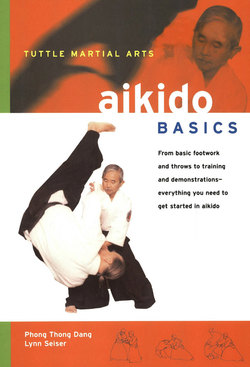Читать книгу Aikido Basics - Phong Thong Dang - Страница 10
На сайте Литреса книга снята с продажи.
ОглавлениеTHE NAME AIKIDO implies that there is only one art, the aikido of O'Sensei Morihei Ueshiba. However, those who studied with O'Sensei Morihei Ueshiba at different times learned different ways of illustrating the same aikido principles and techniques. Some of these students modified those ways and applications of techniques based on their own temperaments, physical limitations, and abilities. These differences have given rise to different styles of the same art of aikido.
Different Branches
There are two major styles stemming from the original aikido of O'Sensei Morihei Ueshiba. The first is the Aikikai branch, directly affiliated with the Aikido World Headquarters, the Aikikai Foundation, and Aikikai Hombu Dojo, established by O'Sensei Morihei Ueshiba and his successors. The second, the Ki-Society style, is in affiliation and association with Sensei Kochi Tohei. Tohei Sensei was a top student and instructor under O'Sensei Morihei Ueshiba.
Classical aikido is referred to as Aikikai, the organization of Aiki. Several different organizations teach variations of the Aikikai style. The Aikikai style of aikido places great emphasis on technical proficiency of technique. Tomiki aikido, or Tomiki Ryu, is a style originated by Kenji Tomiki, who imitated the sport of judo competition in the hopes of acceptance into the educational institutions. Yoseikan Budo, established by Master Minoru Mochizuki in Japan, is a style strongly influenced by judo. Iwama style aikido, as taught by Morihiro Saito, emphasizes the relationship of unarmed techniques executed with ken (wooden sword) and jo (wooden staff) movements. Sensei Gozo Shioda established Yoshinkan aikido, emphasizing self-defense applications. Tenshinkai, meaning the association of heavenly hearts, is the name given to the fluid and powerful style of aikido from Vietnam founded by master Phong Thong Dang.
Koichi Tohei, a dan under O'Sensei Morihei Ueshiba, founded the Ki-Society in 1971 to reflect a different emphasis and curriculum. The Ki-Society, known as Shin Shin Toitsu aikido, means aikido with body and mind coordination. Tohei Sensei brought aikido to the United States at the request of O'Sensei in 1953. The Ki-Society style of aikido emphasizes the development and use of ki to remain calm and relaxed in stressful situations in daily life. The Ki-Society combines ki development and breathing exercises with soft, flowing aikido techniques. Seidokan aikido, founded by Roderick Koayashi in 1981, draws from Tohei Sensei's Ki-aikido but emphasizes a balanced practice of principles and techniques
While the emphasis of these two major branches of aikido is different, their basis and origin are the same. There may be several other styles, or branches, of aikido—too many to keep track of. Many independent schools have opened and are actively training students. Their styles may not be covered here, but their exclusion is not meant in any way to be disrespectful.
